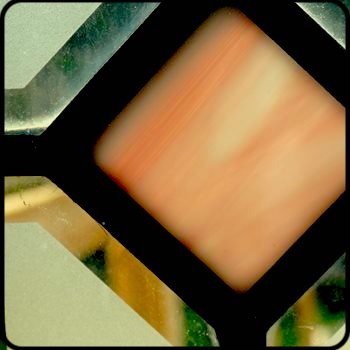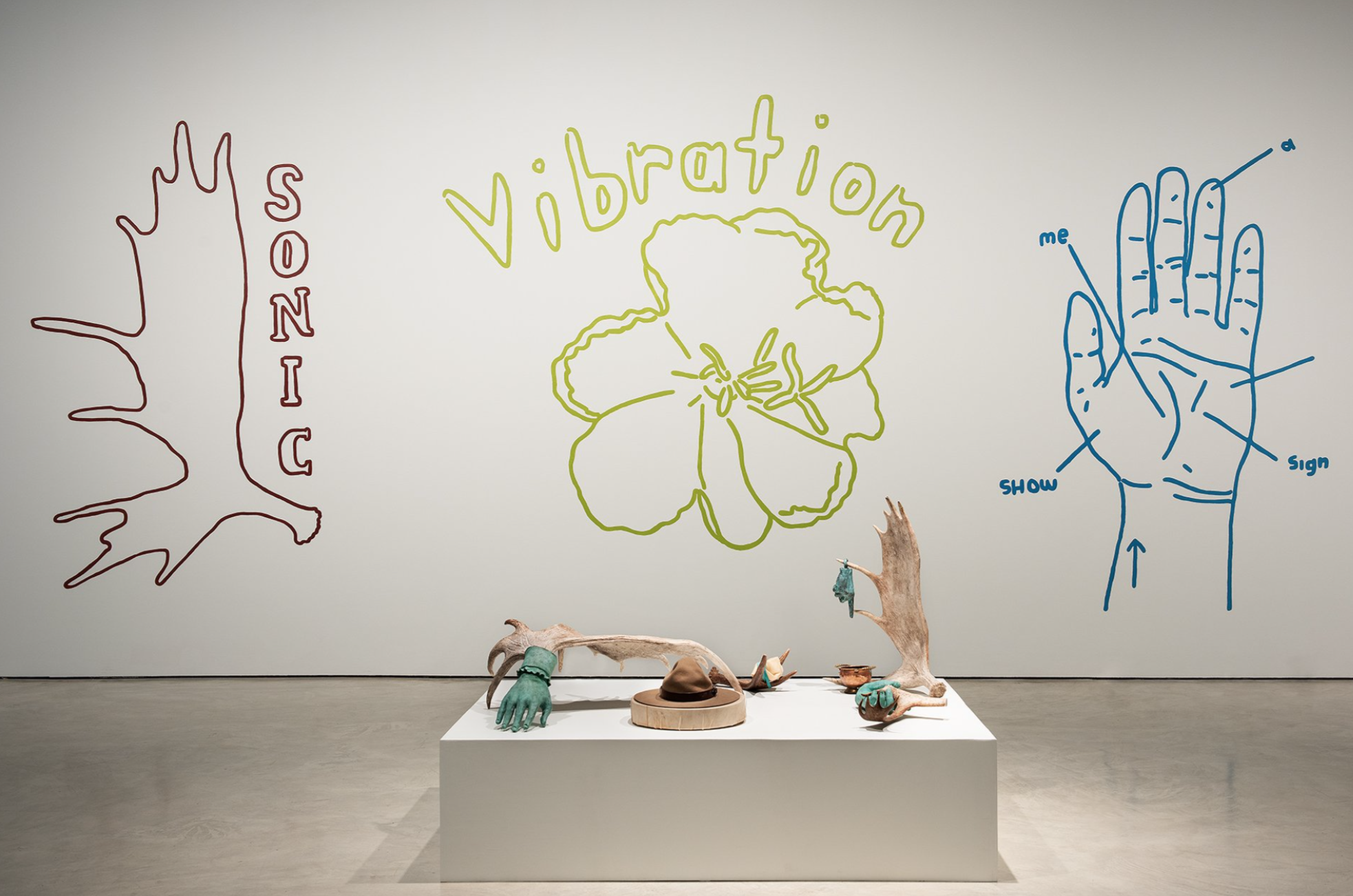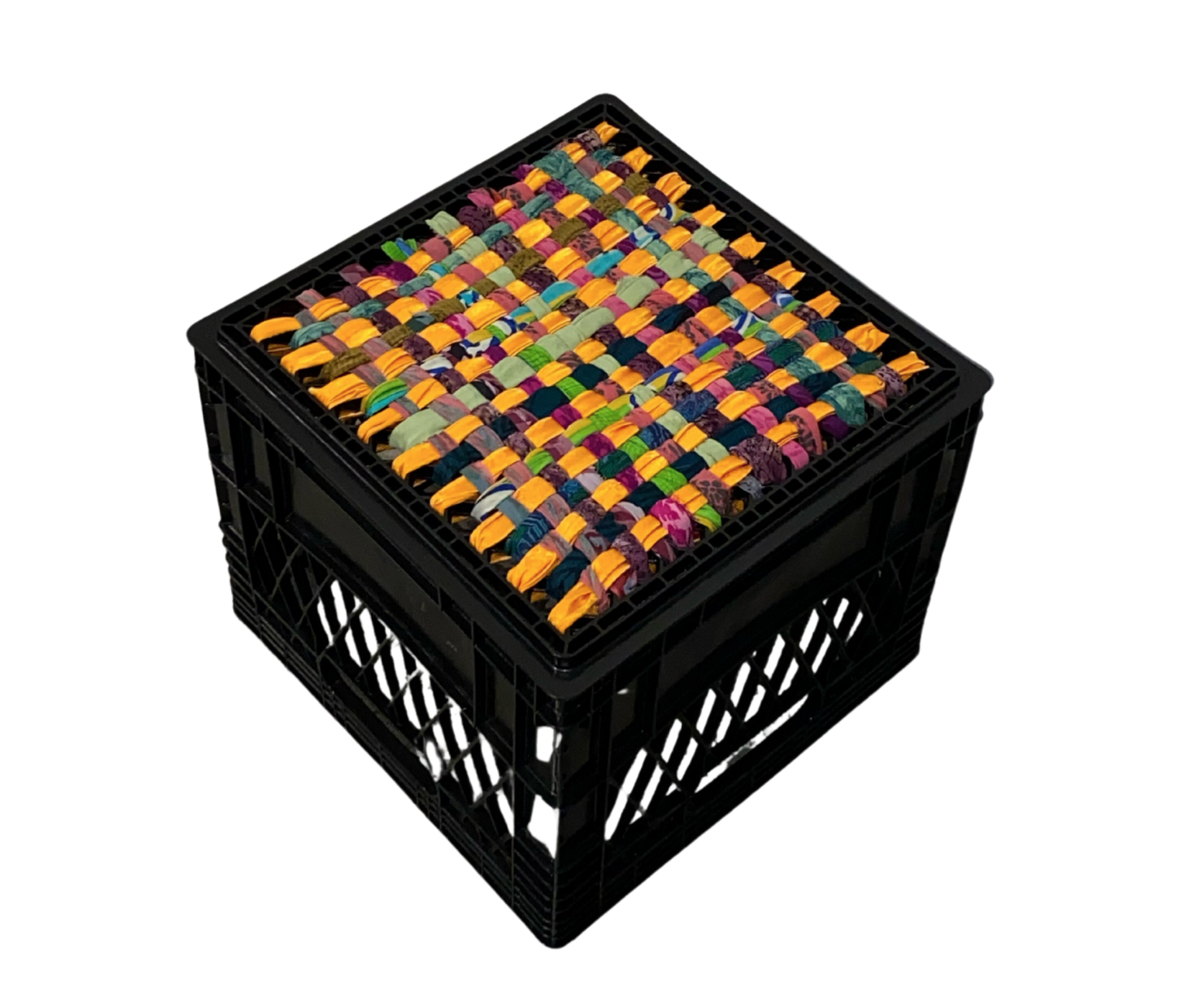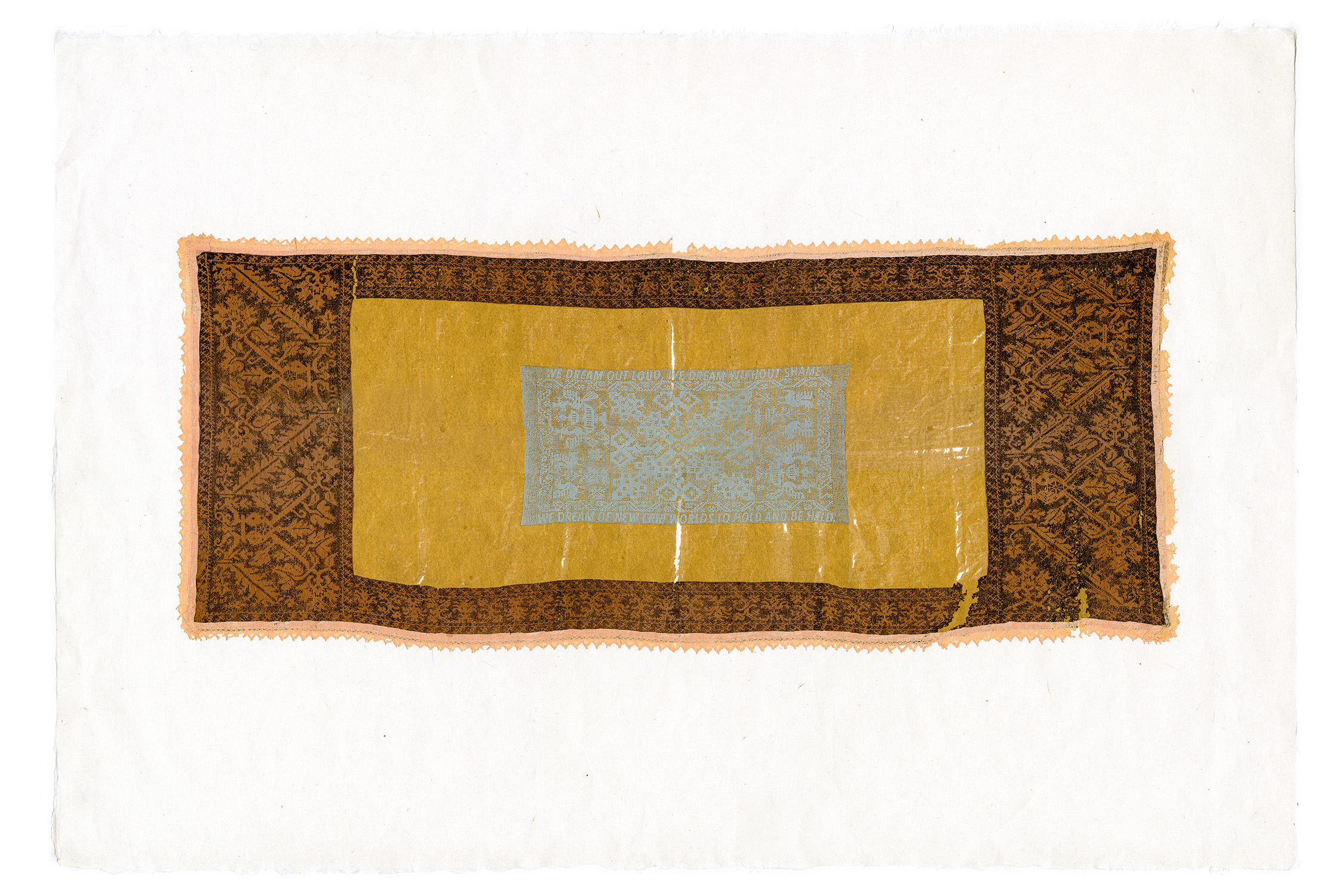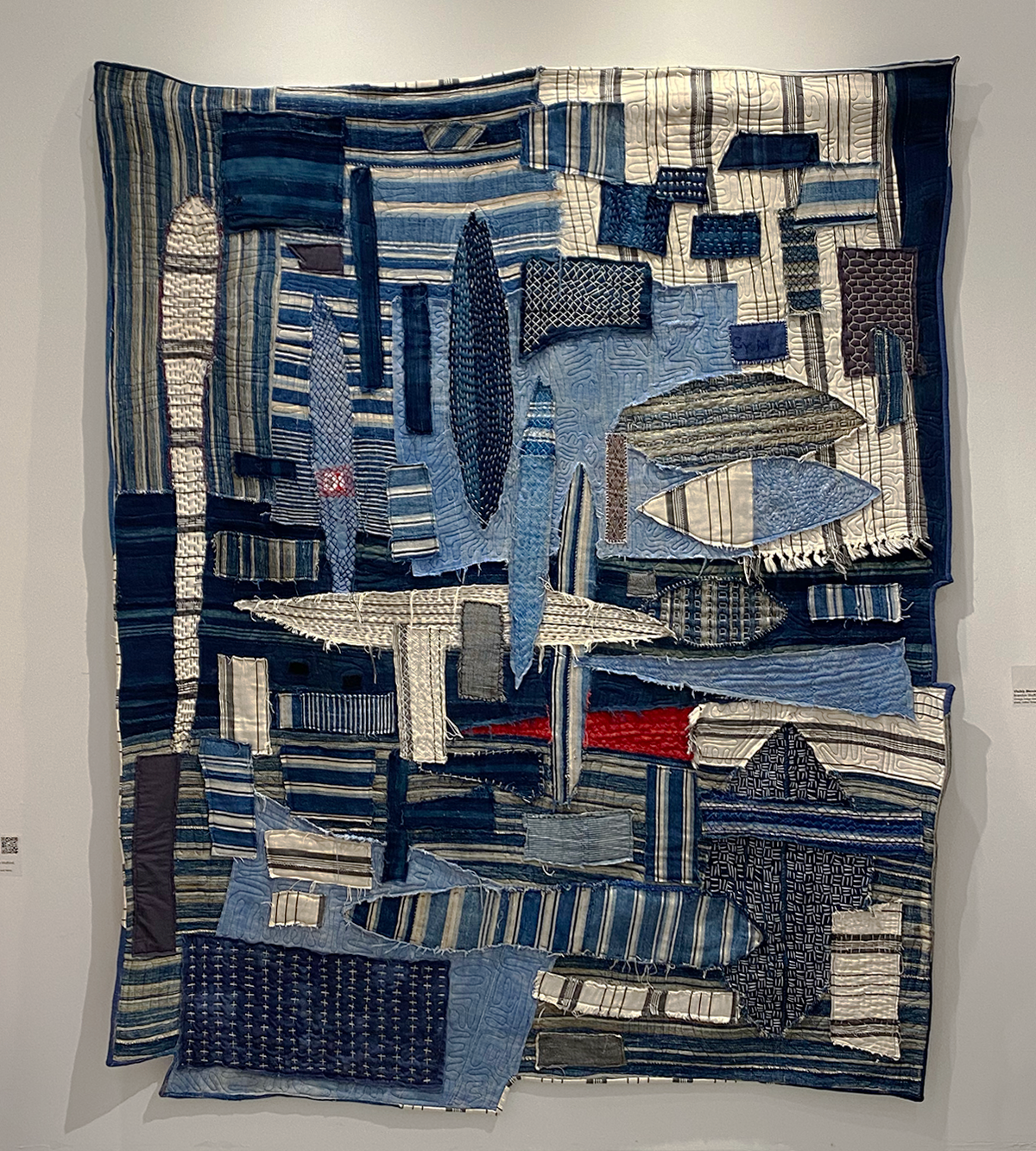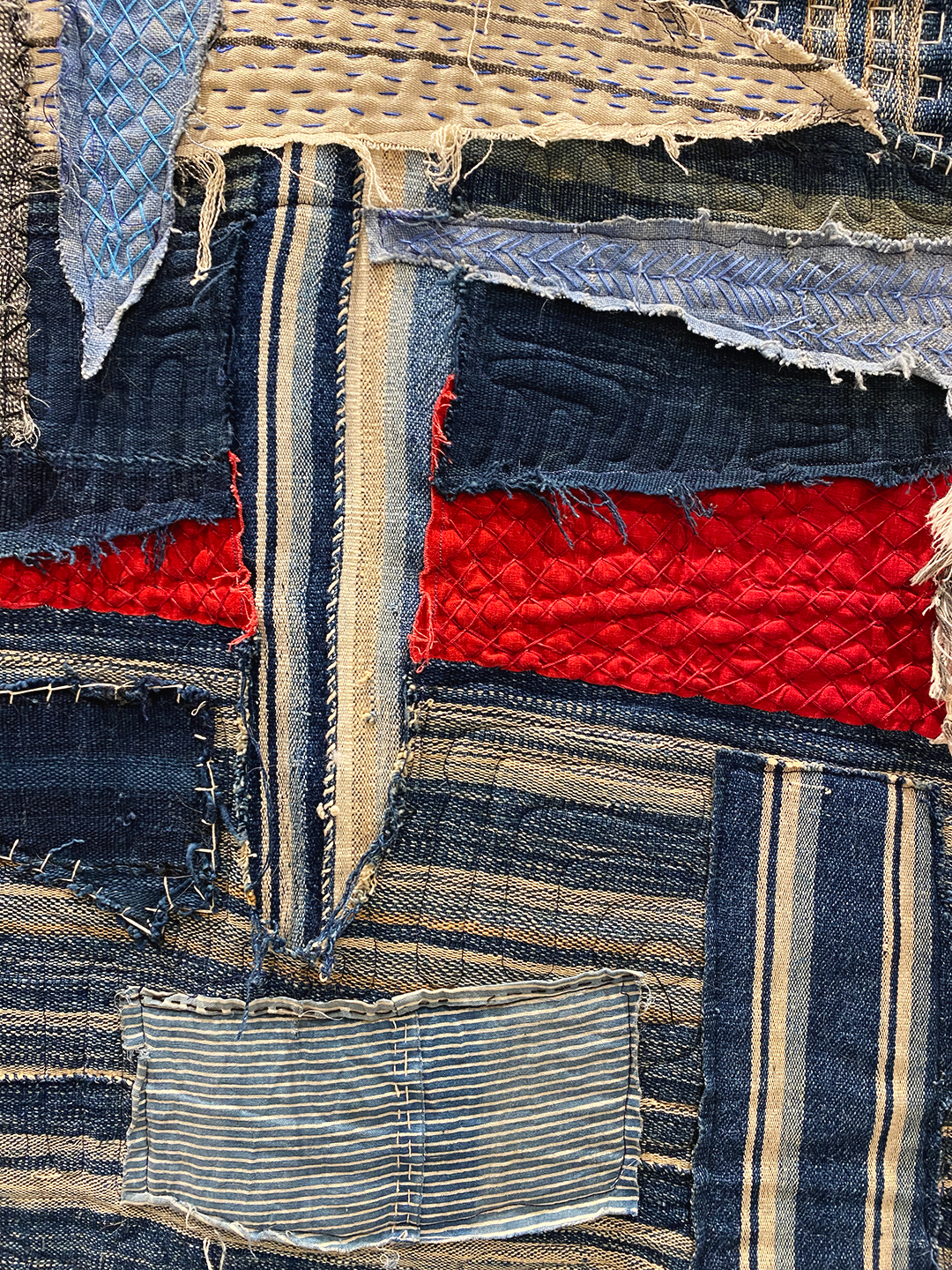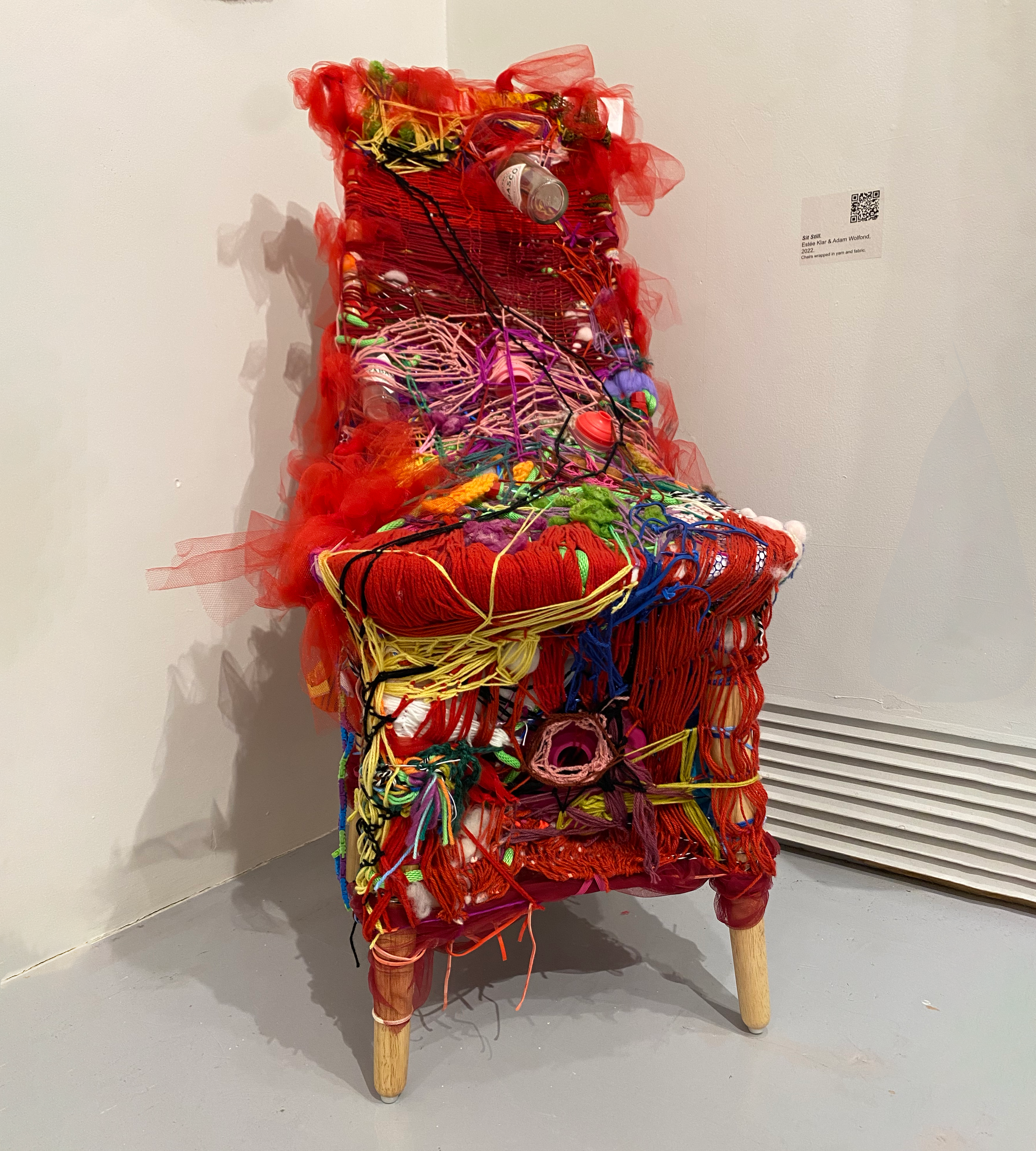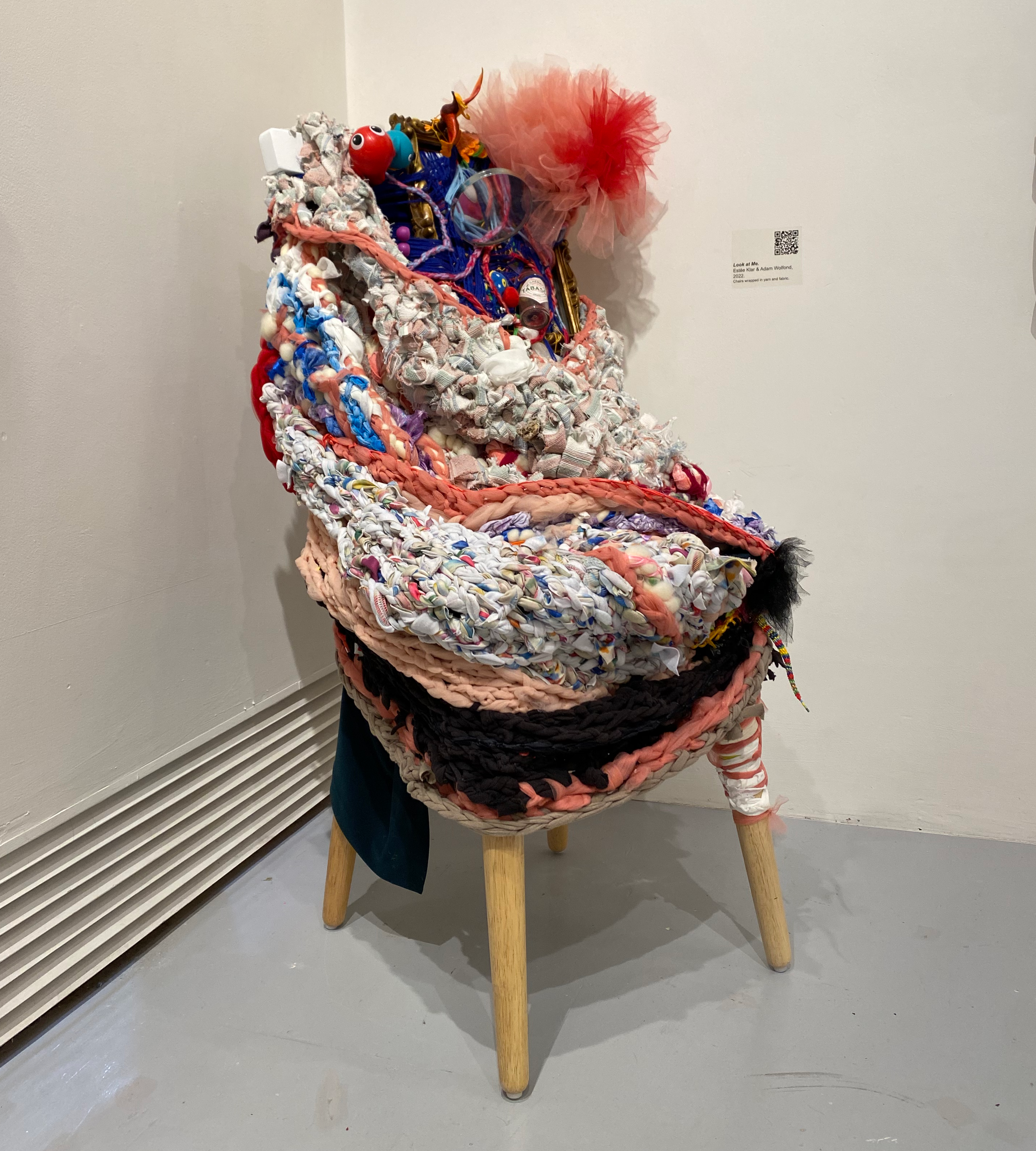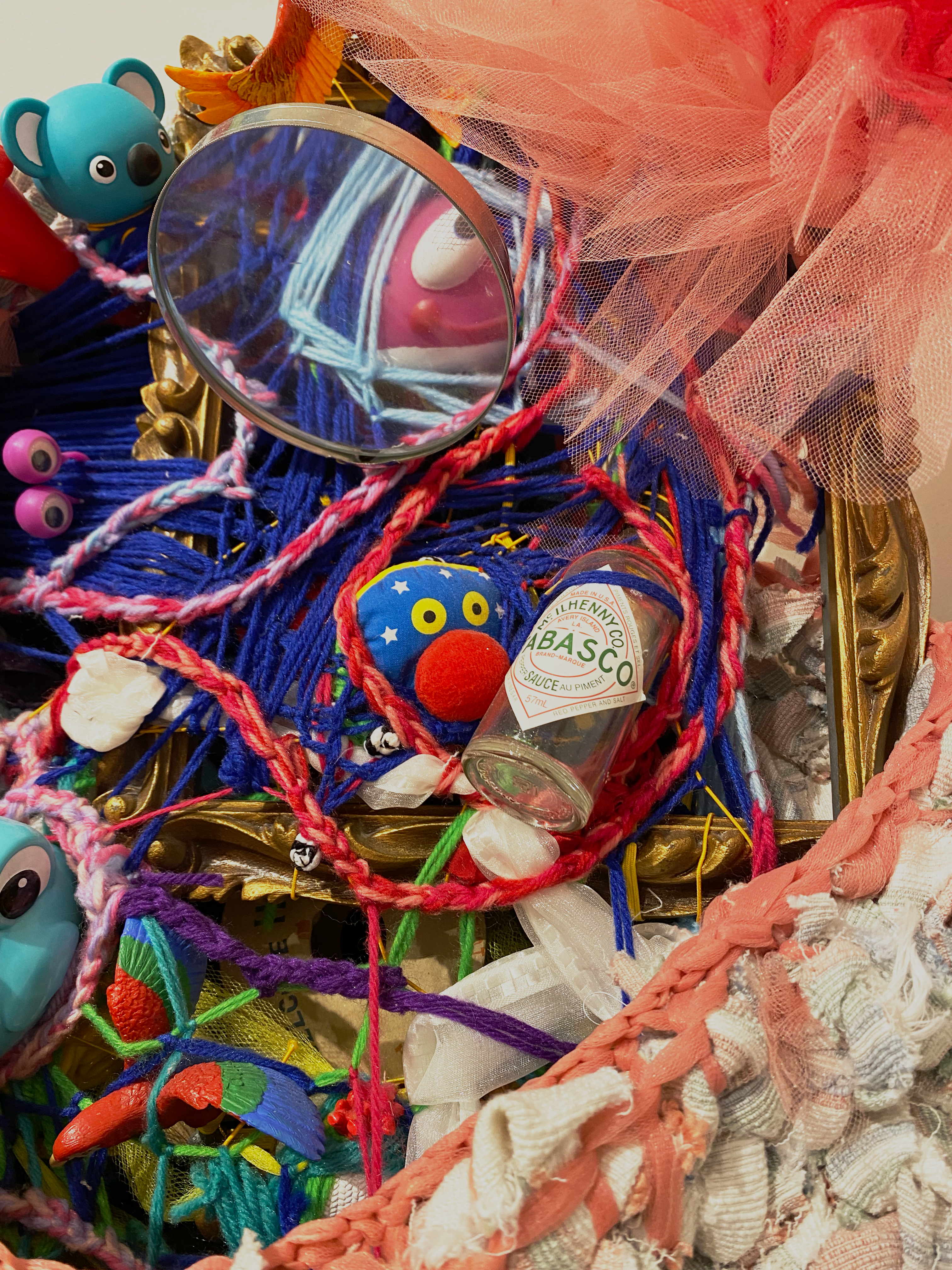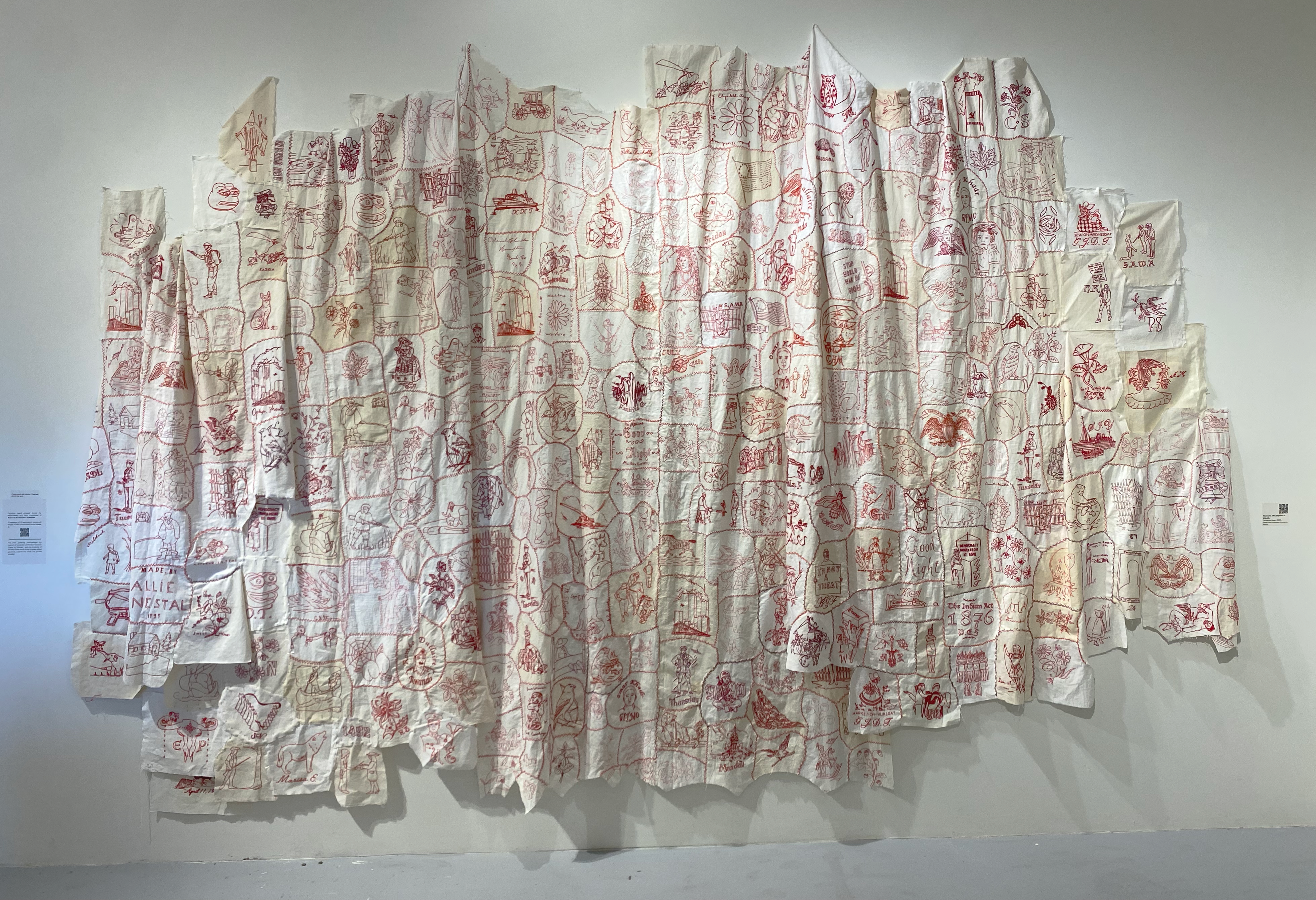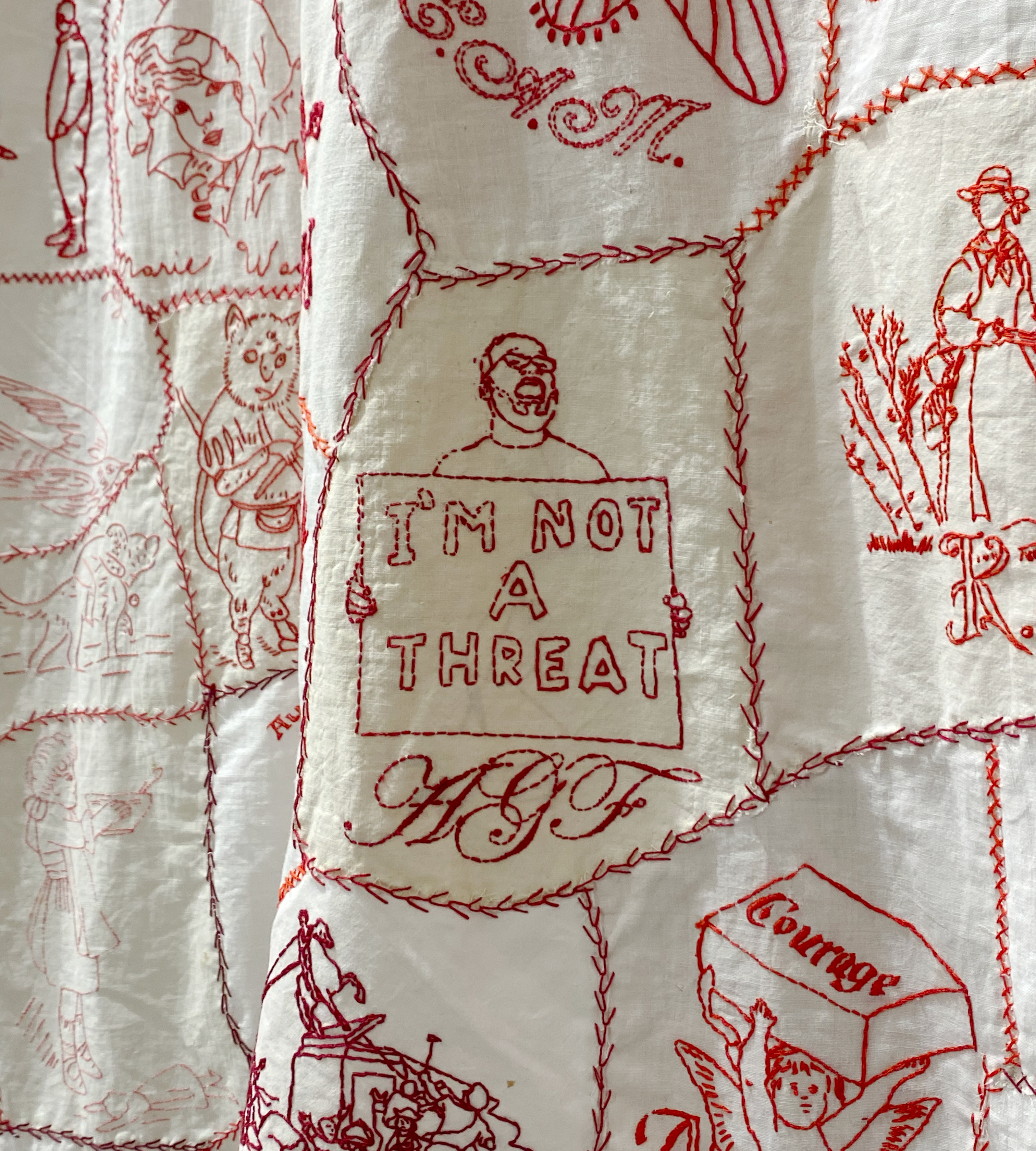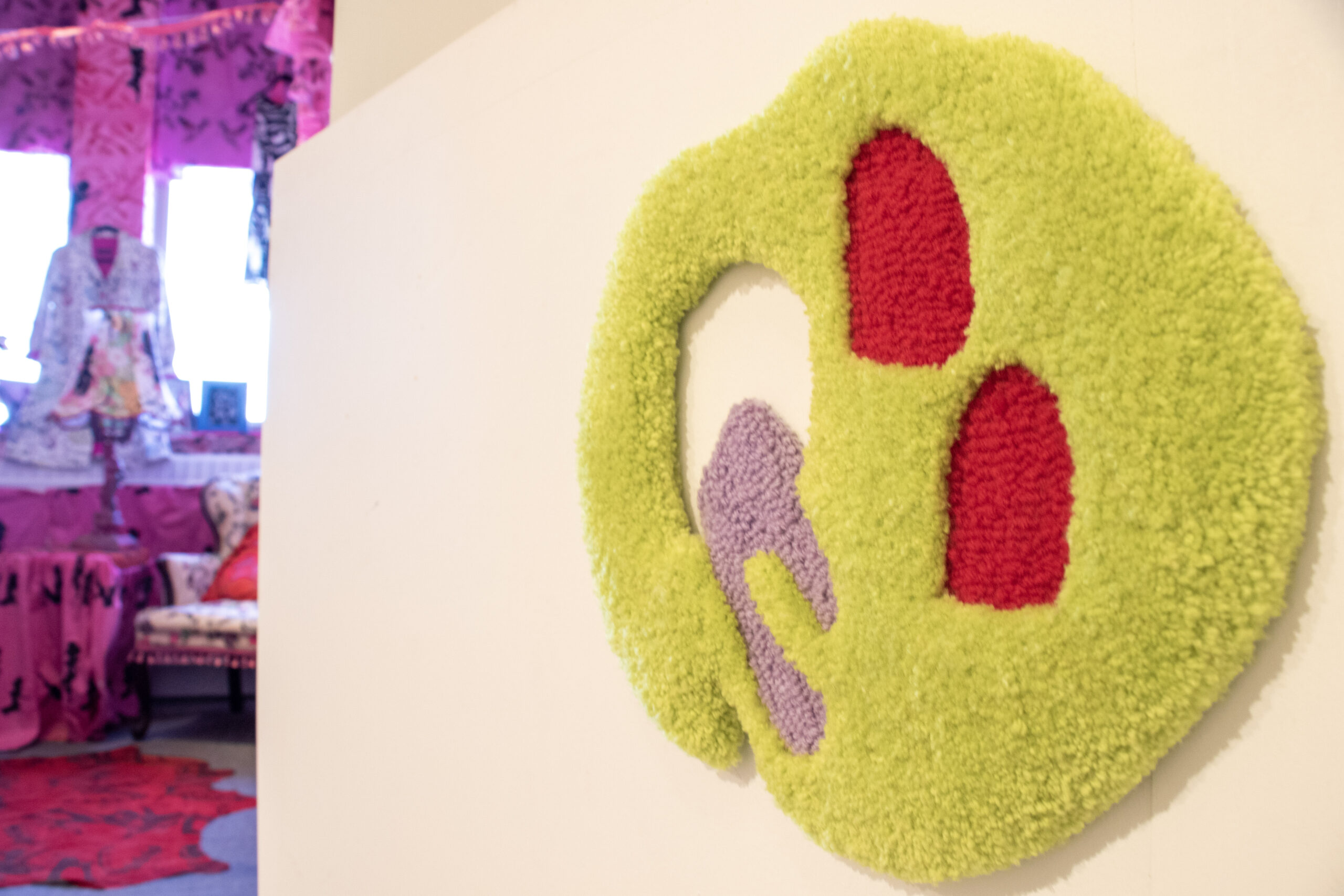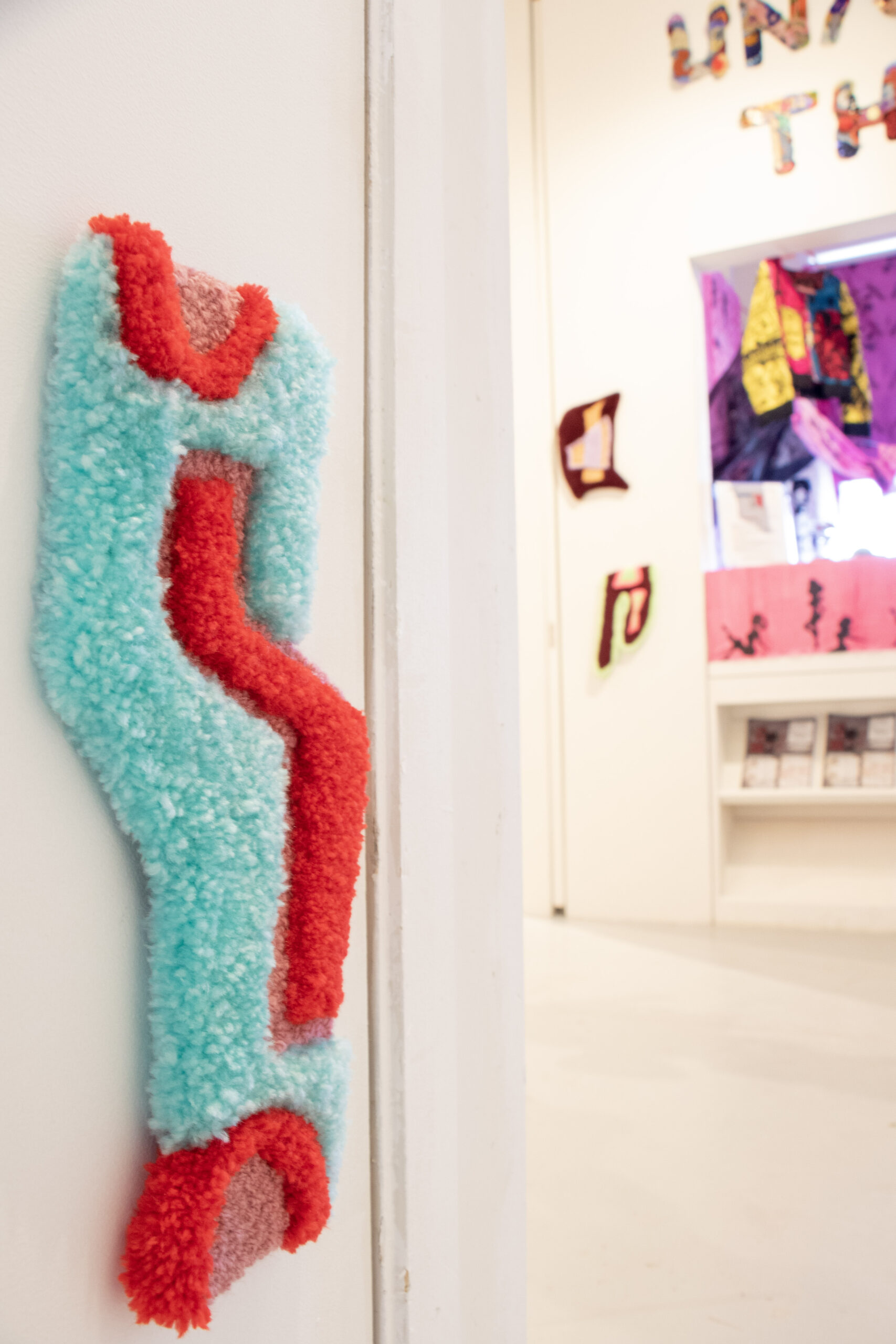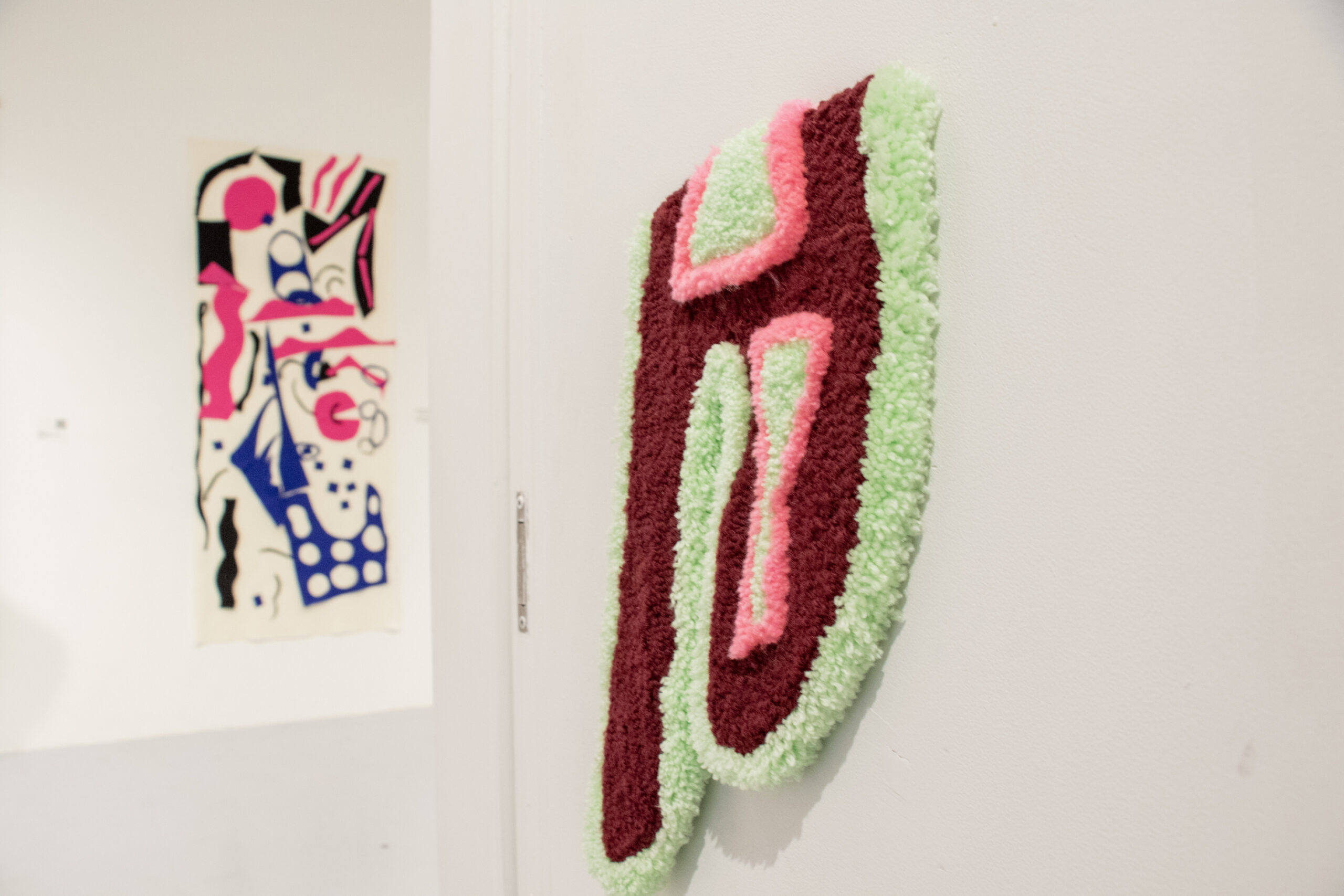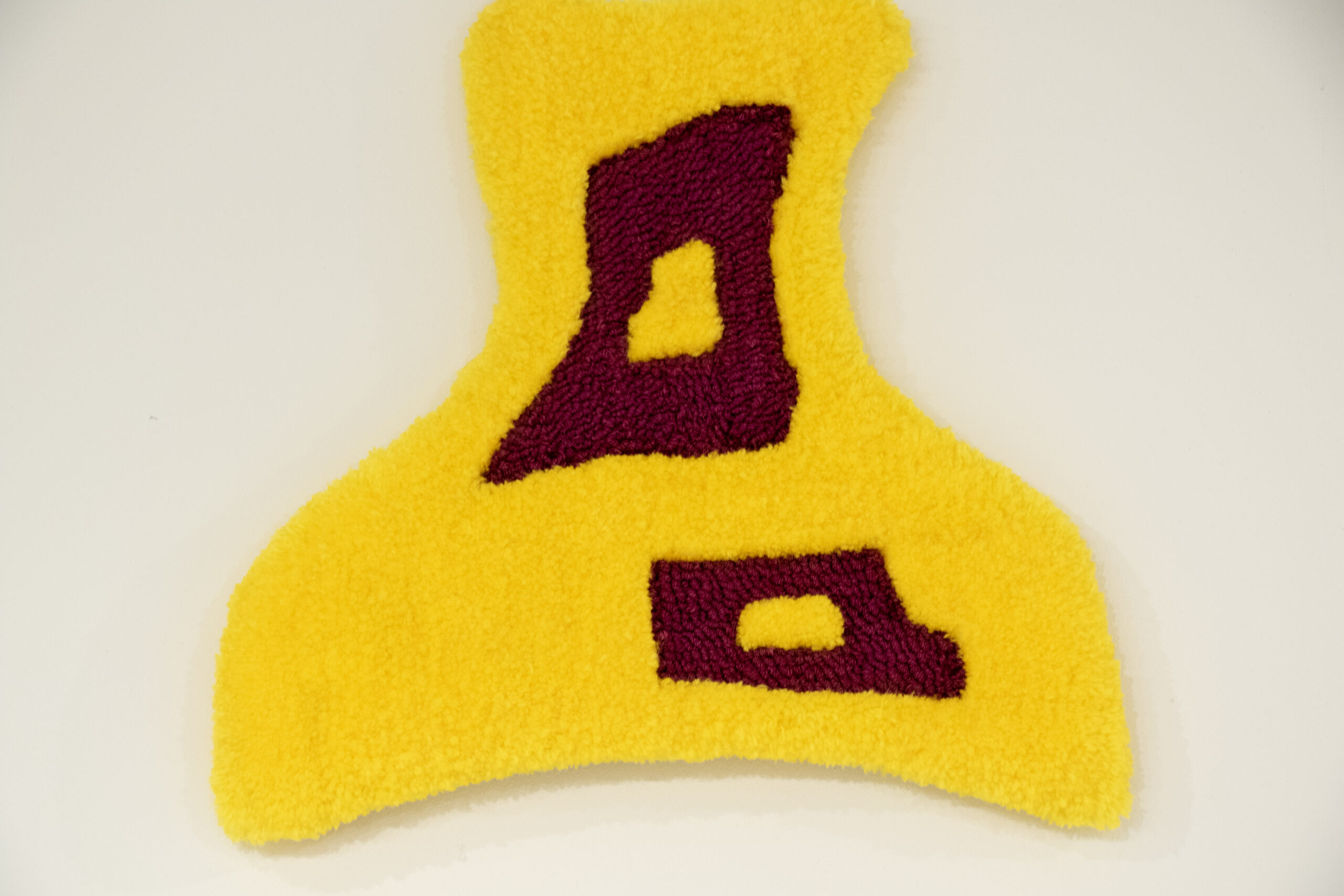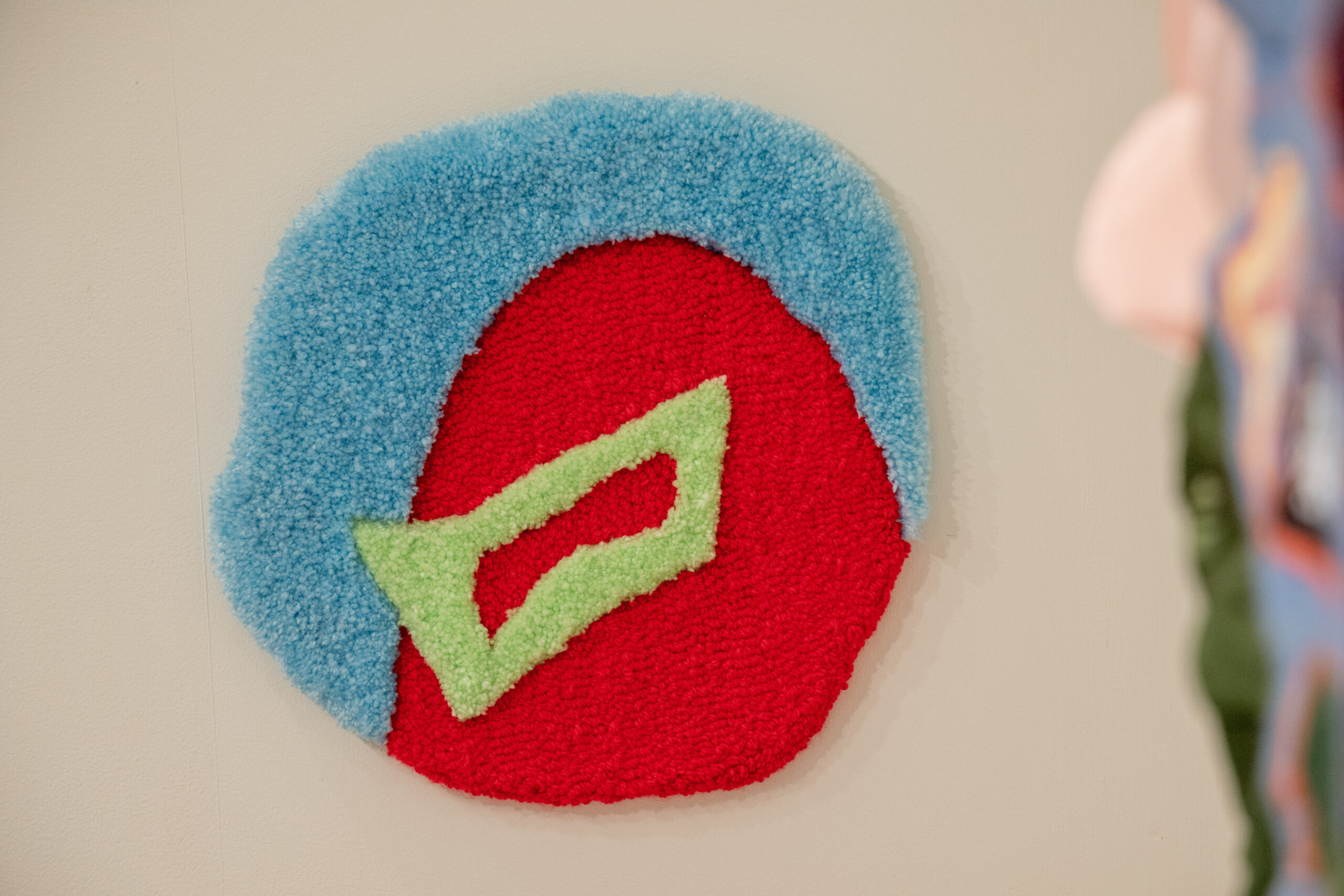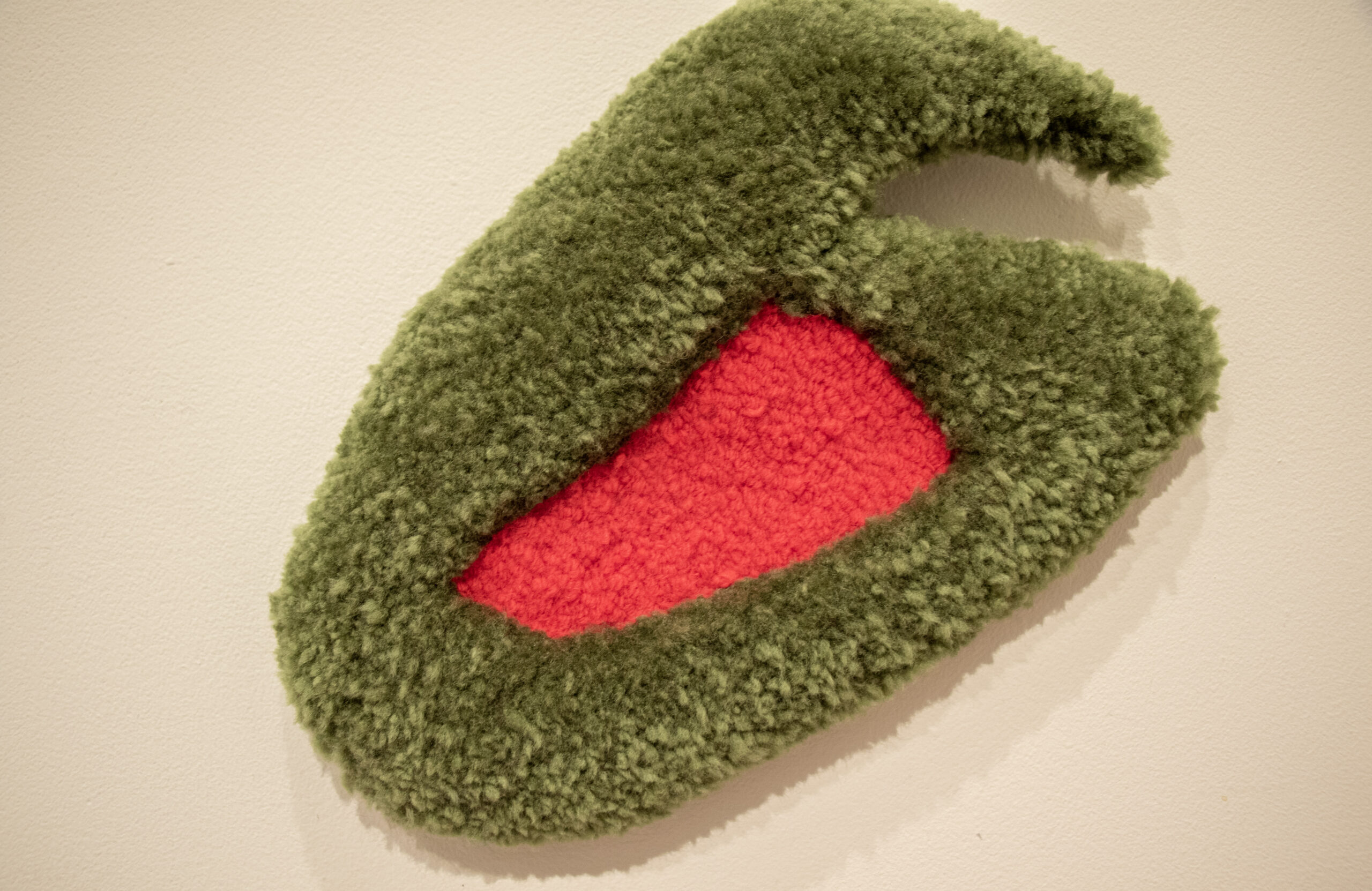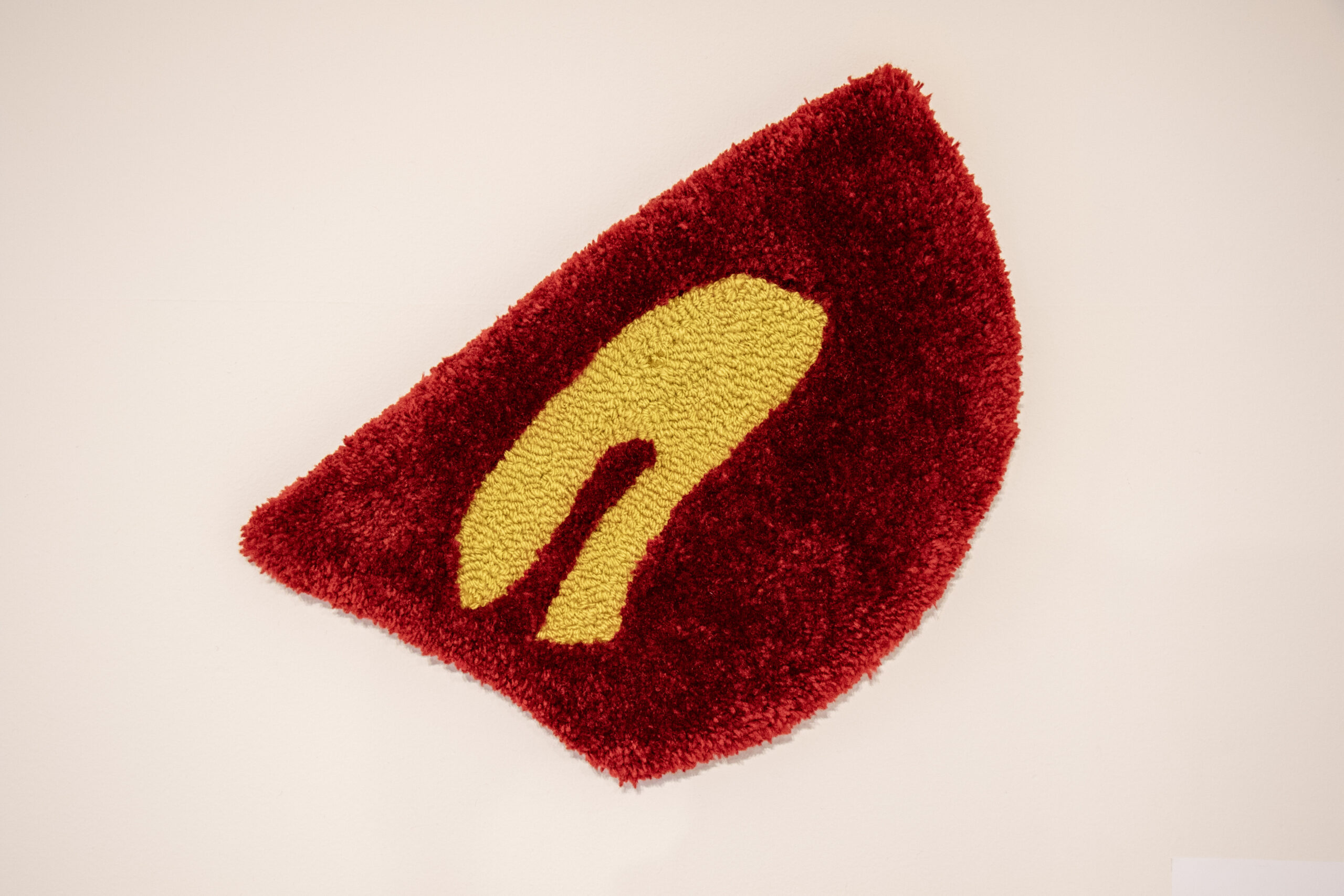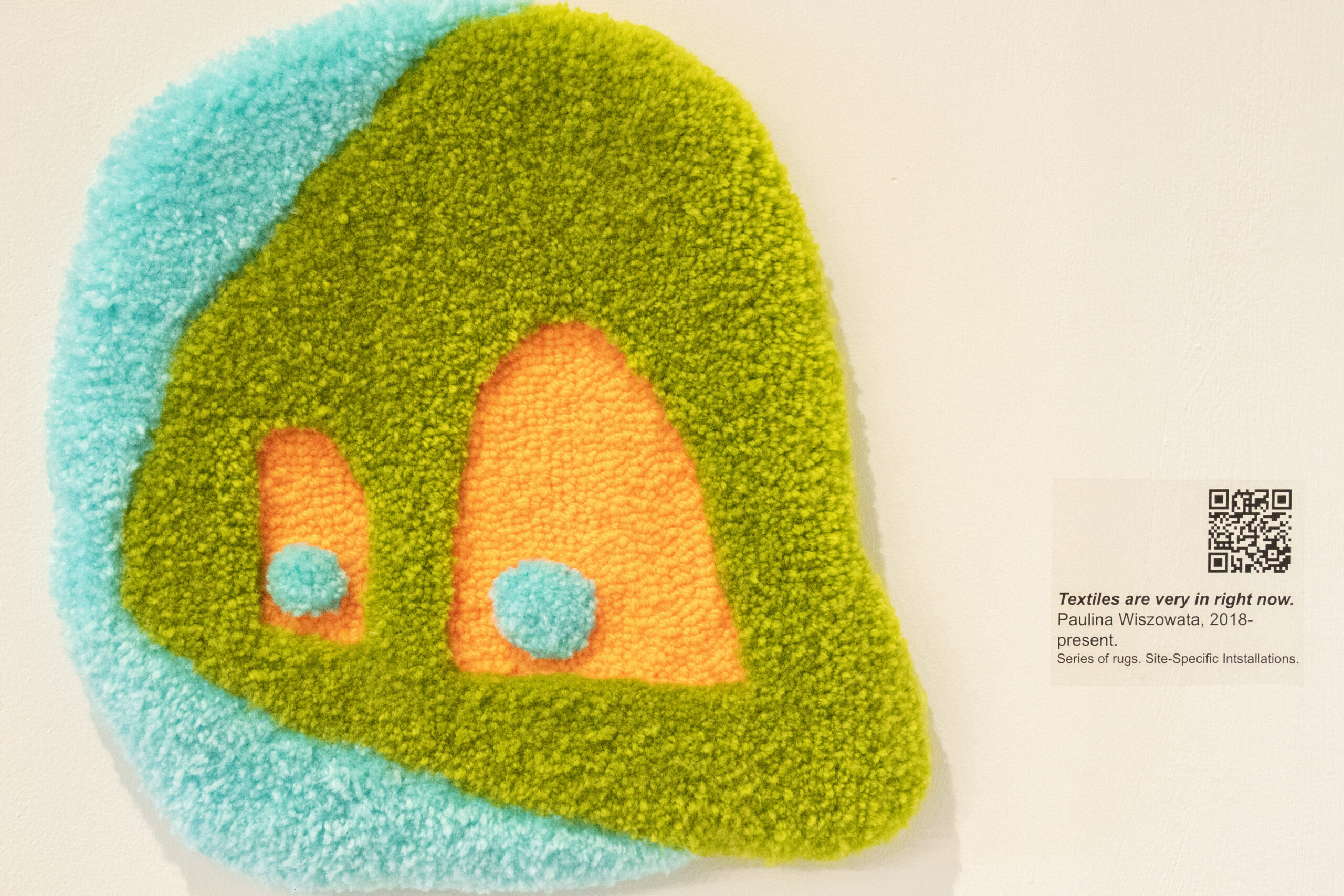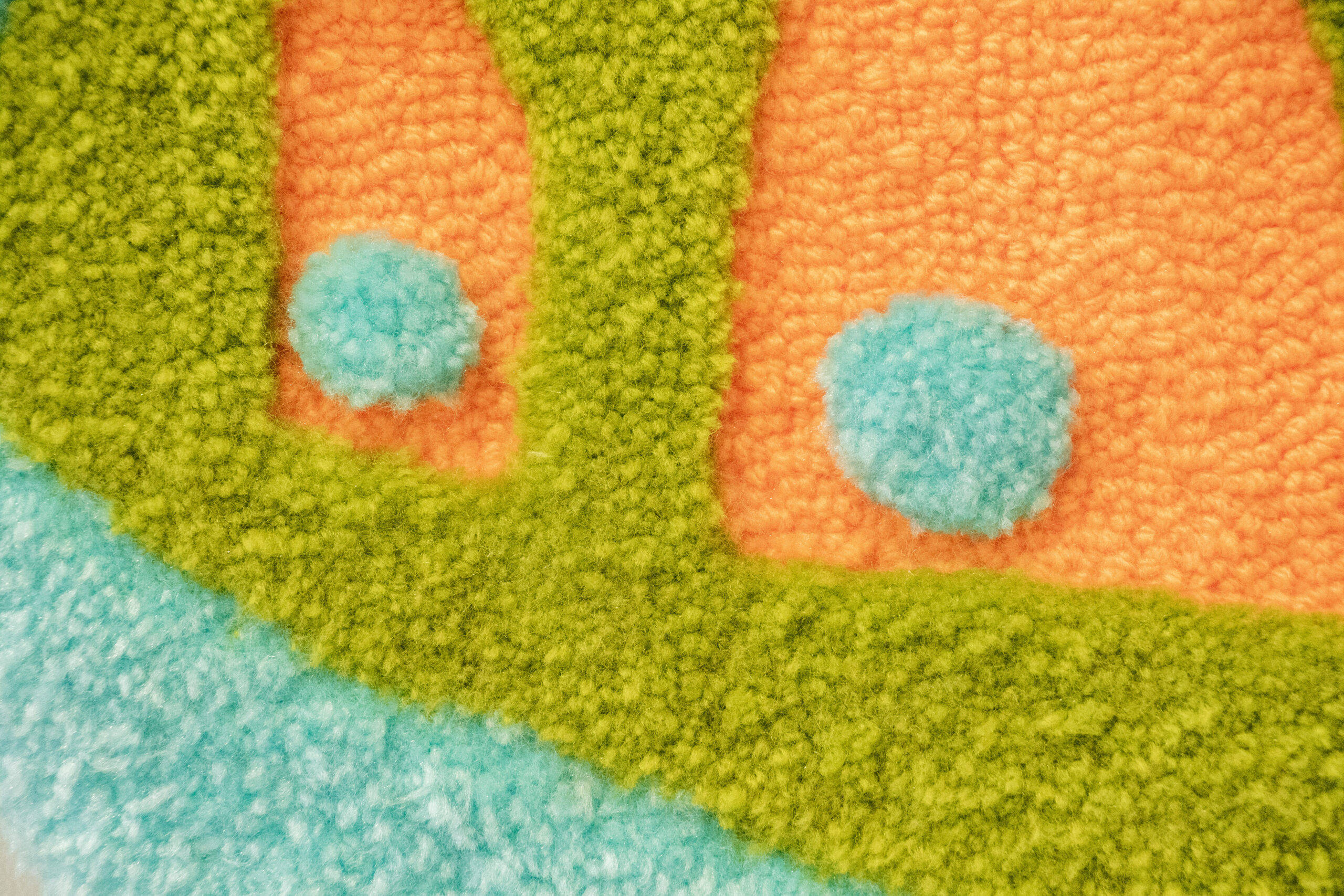Image Credit: waiting in line at the corvid cafe, m. patchwork monoceros
In Praise of Voice Notes and Penguin Pebbling (part of Mourning Microcosmmutes), 2023
Digital photographs laser printed on cotton canvas, embroidery, looped digital video (silent)
Image: waiting in line for the corvid cafe, an embroidered photo-quilt from In Praise of Voice Notes and Penguin Pebbling, 2023.
Image Description: A close-up image of a diagonal stained glass window with transparent, muted coral, and light blue panes joined by black lead lines. The dim daylight of the outside threshold is visible through the panes.
WORK STATEMENT
In Praise of Voice Notes and Penguin Pebbling* is an excerpt from the series-in-progress, Mourning Microcosmmutes, a project featuring embroidered photo-quilts and digital video. Both documenting the various paths and barriers that shape my domestic atmosphere as an ambulatory wheelchair user and disabled “shielder,” this series also highlights the access intimacy within qrip careships as represented through the life-sustaining exchange of mobile phone voice notes.
For other disabled shielders like myself, the pandemic boldly persists while the scope of our social geography progressively decreases, leaving the walls and roofs of our homesteads and headquarters the only “protected” places for us to exist — and even then, we were not always safe.
For this series, I have focused on the transoms, portals, and points of transition I pass through dozens of times a day within or adjacent to my home. ‘Micro’ here refers to the relative size of my “commute” as well as the zoomed-in, microscopic composition of the images and clips in my work. I want to honour this space that protects me from [some] harm while acknowledging that, by being the only safe place for me to be, my home also limits my autonomy beyond its threshold.
Myself and my qrip-kin (qrip = queer + crip) have lost whole groups and networks of loved ones — not only to the virus and its complications, but to the evaporation of trust and the permeating grief that replaced the love, respect, or care we previously shared. Many of us do not know how we will recover from the injury of being thrown away by everyone except each other.
The 4 stitched soundwaves included are lifted from conversations with other queer and disabled shielders. The embroidered quilts, following left to right, are:
lunch break view: the lace curtain obscured front window across from where my tube feeds are set up and where one of my cats perches to peruse the neighbourhood
meltdown in the gender neutral bathroom: bathroom wall damaged as a result of an autistic meltdown related to medical ableism
breakroom kitchen: the floor junction between my kitchen and living room
waiting in line at the corvid cafe: the stained glass of the back door where I birdwatch while voice recording
**Penguin Pebbling is a little exchange between two people to show that they care and want to build a meaningful connection. For autistic people, giving little gifts spontaneously can be a meaningful way of communicating that you are thinking about someone and that you care. (https://www.autisticrealms.com/post/penguin-pebbling-an-autistic-love-language)
ARTIST STATEMENT
My practice threads multiple disciplines and approaches together in an exploration of balance and intracorporeal groundedness as a Black, agender, disabled creator and creature. Sourced from documentation of my disabled domestic sphere, digital and tactile media (here, embroidery) coalesce to support a narrative process that allows and aims to make a space for grief to live openly.
My work and practice trouble the compulsory in/visibility of marginalized bodies by peering into ways inherited grief is somaticized and how this somatization impacts our daily movements. My hope is that through creating and offering work that explores and cares for my own experiences of mourning, I can create a landscape for audiences to sit with and care for their own.
Artist Bio
m. patchwork monoceros is a poet and interdisciplinary artist exploring polysensory production and somatic grief through text, fiber, and film. Their work considers a collective qrip (queer+crip) consciousness by connecting to marvelous bodies living with complexity as sick or disabled. A Black creator of Jamaican heritage, m. was among the winners of the 2023 Grant for Disabled Artists from Arts AccessAbility Network Manitoba. In 2022, monoceros received the Arts Leader Award and, in 2021, the Emerging Excellence Prize, both from the Manitoba Arts Council. monoceros’ writing and artwork have been presented across Turtle Island and internationally. m. patchwork aka patch is based in Treaty 1/Winnipeg, MB; home of the Métis First Nation and the traditional territory of the Anishinaabe, Dene, Cree, Dakota, and Oji-Cree Nations. Their first collection of poetry, Remedies for Chiron (Radiant Press) was released in Spring 2023.
Back to ‘wherever you are is where i want to be‘
Image Credit: Art Windsor-Essex
nadyes / you come back, 2022
Bronze, shed moose and elk antlers, acrylic paint
Image Description: A rectangular white platform sits in front of a white gallery wall on a concrete floor. Upon it rests a tableaux of bronze cast hands, shed moose and elk antlers, and a light brown flat brim felt hat such as those worn by the RCMP. The wall behind this assemblage has three colour illustrations on it. From left to right they are: a burgundy-coloured outline of an antler with the word “sonic” written vertically in capital letters on its right side; an apple green outline of a hibiscus flower with the word “vibration” painted above it in lowercase; a cerulean illustration of a hand and wrist with lines demarcating, clockwise from the top, the fingertip of a ring finger, folds and creases of the inside of the palm, and the outermost part of the inner palm. An arrow on the inside of the wrist points upward to the hand’s palm and each of the four lines is labeled with a single word, reading: “show” “me” “a” “sign”.
WORK STATEMENT
With nadyes / you come back, Logan MacDonald uses sculptural installation to lyrically fixate on the learning and communication that exists outside colonial norms and to consider how these colonial mechanisms can be subverted. Presented as a series of arranged sculptural installations and imagery traced on the wall, MacDonald’s work forms a large coded assemblage, with each piece, in some way, gesturing to the embodiment of knowledge — how our bodies learn and teach through movements, vibrations, bodily cues and how these signals have the capacity to transmit and extend between generations.
Bronze is used here as a symbolic signifier of the colonial narratives and systems imposed on our landscapes and bodies as well as the hierarchical ways in which we are expected to teach and learn. MacDonald employs these bronze pieces in a dismantled/fragmented state to subvert their power, absorbing the structures as aides in forming a tableaux that welcomes new meanings, histories, perspectives, movements, conversations, teachings. This conceptual approach is continued in his use of shed elk and moose antler, a biological material that references the animals’ speculated ability to sonically hear both mates and prey.
An attempt to lyrically highlight our capability to communicate beyond colonial language, nadyes / you come back illustrates how Indigenous, queer, and crip folks continue to strategize to communicate our knowledge, needs, and desires despite living alongside colonial systems designed to ensure our erasure.
Text by Amanda Cashia, edited here by Sarah-Tai Black
Artist Bio
Logan MacDonald is an artist, curator, writer, educator, and activist who focuses on identity and belonging through queer, disability, and decolonial perspectives. He is of mixed-European and Mi’kmaw ancestry and identifies with both his Indigenous and settler roots. Born in Summerside, Prince Edward Island, his Mi’kmaw ancestry is connected to Elmastukwek, Ktaqamkuk. His artwork has been exhibited across North America, notably with exhibitions at L.A.C.E. (Los Angeles), John Connelly Presents (New York), Ace Art Inc. (Winnipeg), The Rooms (St. John’s), and BACA (Montréal), His work has been published by Goose Lane, Canadian Art, C Magazine, UN Projects, and more. In 2019, MacDonald was longlisted for the Sobey Art Award and was honoured with a six-month residency at the Künstlerhaus Bethanien in Berlin. He holds a BFA in Interdisciplinary Studies from Concordia University and a MFA in Studio Arts from York University. In 2019 he was the lead Accessibility Consultant for the Toronto Waterfront Sidewalk Labs project; in 2021, he was a keynote speaker for the Canadian Public Arts Funders (CPAF); and in 2022 he was a respondent for the Ontario Arts Council’s 2022-2027 Strategic Plan. Currently, MacDonald is a Canada Research Chair and Assistant Professor in Studio Arts at University of Waterloo.
Image Credit: Harmeet Rehal
Manjas as Mobility Aids, 2023
Black milk crates, repurposed saris and dupattas, rope
Image Description: A single black milk crate is pictured. The top surface of the crate has various silk sarees, embroidered Panjabi fabric, and rope woven through it both horizontally and vertically, creating a crosshatch of golden yellows, deep navy blues, hints of turquoise, vibrant patterned pinks and purples, as well as faded greens, blues, and browns. Some of the fabrics are a solid hue, while others have a pattern that peaks out from within each warp and weft.
WORK STATEMENT
Manjas are Panjabi day beds/cots that are traditionally made with a simple wooden frame and colorful hand-woven rope. While, in western architecture and design, it is rare to find accessible spaces to rest in ways that are collective and whole, in Panjabi culture, Manjas are found in shared spaces that are both indoor and outdoor. Lying down and resting while in community is a major consideration within private and public Panjabi landscapes — Manjas give us permission to rest in relation to one another and their presence viscerally shifts our shared spaces.
This piece re-imagines the traditional Manja through upcycled, hand-woven Panjabi textiles and milk crates, the latter being an extremely utilitarian material. It attempts to honour the crip, working class, and racialized ritual of finding milk crates in factories, cleaning supply closets, kitchen fridges, back alleys, and flea market change rooms and using them as a seat or propping ourselves on them to ease our bodies during taxing shifts. This crip access hacking recalibrates the normative design and purpose of milk crates into a mobility aid. Bounding crates together to form a Manja allows for a more collective mobility aid that creates room for us to relationally rest and spill over. Softening the rigidity of the crates’ structure with woven Panjabi fabrics also creates room for a gentler and softer place to land.
I welcome you to sit on the Manja, to prop yourself on it, or to stim and engage with all the different textures throughout. Stay a while, there is no rush — I want you to rest and play with this piece however feels good.
ARTIST STATEMENT
Coming from an intergenerationally disabled and immunocompromised Sikh-Punjabi family full of artists and makers who have complex experiences around displacement, state violence, survivor-hood, and substance use, I arrived at my multidisciplinary arts practice to make sense of these gritty histories and griefs. My practice is also shaped by an urgency to archive the crip knowledge from my lineage and all of the intricate and messy ways they materialize in me and around me. Within my textile work specifically, I repurpose found fabrics from my lived experience that hold complex memories and stories. Unraveling and adorning archived materials from my life allows me to give them new portals and meaning and is, ultimately, a queering and cripping that is so grounding. My textile work is also an amalgamation of all the techniques and storytelling that the crip and working class Panjabi aunties in my life passed down to me at the kitchen table. Their vast knowledge of weaving with jute, sewing, quilting, crocheting, natural fabric dying, traditional Panjabi mirror (sewing glass mirror into textile), and fabric painting shows up intimately in the ways that I approach my textile work. The slowness and crip hacks I embody in my craft are informed by these relations and my textile practice is an attempt to honor these aunties and all of the vibrant, juicy, and lush possibilities that Panjabi textiles offer us.
Artist Bio
Harmeet Rehal is a fat, trans, Disabled, Sikh-Panjabi multidisciplinary artist, educator, and organizer based in Tkaronto. Harmeet primarily does illustration, collage, painting, and textile arts and facilitates community arts programming on these mediums. They are currently an MA student in the Critical Disability Studies program at York University, where their research further explores the themes of their arts practice: pandemic care networks, intergenerational crip archives, hacking normative design, Panjabi survivor-hood, and fat temporality.
Harmeet has recently completed artist residencies at the Possibilities Podcast, ArtworksTO Program, YTB Gallery, Creative Users Project’s Sensory Shift, and National AccessArts Centre. They are also the coordinator for the Digizine Residency, a virtual zine residency for Deaf and Disabled 2SQTBIPoC. Their art has been shown at the Art Gallery of Mississauga, Spadina Museum, and sold at pop ups and markets at the Leslie Lohman Museum of Art, AGO, Hard Feelings mental health shop, and Stakt.
Harmeet also comes from an accessibility coordination and grassroots community organizing background. This work grounds the intentions of their arts practice and, in all their roles, Harmeet is interested in creating portals to a cripped otherwise.
Image Credit: Chelsey Campbell
a garland for patty, 2022
Laser-engraved Moriki Kozo, Oguni Kakishibugami, and Chiri Kozo tissue on heritage washi paper
Image Description: Suspended on a white gallery wall by way of two circular magnets, a delicate scarf rests on a sheet of handmade paper. An assemblage of warm ochres, fleshy pinks and the rich hue of persimmon baked in the heat of the afternoon sun, the scarf is warm and inviting, beckoning us closer. The textile edges are worn with only remnants of the salmon-pink fringe remaining in tact. Despite the obvious wear, the piece feels loved, draped to showcase the interlocking fibres of the careful needlework. In the center of the scarf is the innermost of three rectangles. Gray-ish blue and containing a decorative patterning that contrasts against the ochre’s warmth, the rectangular space visually vibrates as the colours clash and integrate. Emerging from this clattering of ochre and slate blue are the words ‘WE DREAM OUT LOUD, WE DREAM WITHOUT SHAME, WE DREAM OF CRIP WORLDS TO HOLD AND BE HELD,’ embroidered just within the rectangle’s horizontal borders.
WORK STATEMENT
The intimate embrace of the warp and weft in textiles are like our crip care networks; each thread, every stitch, is made stronger by its interconnectedness to one another. Sourcing text from disabled writers, conversations with my community, as well as personal journal entries from the pandemic, each cloth is etched with a fragment of our story — a narrative thread captured on the surface. Utilizing a laser engraver to critically expose the warp and weft of the handkerchief, each cloth requires a delicate touch to keep the text from fraying and disintegrating from the surface of the weave. The fragile state of the handkerchief mirrors the tender state of our stories, of recovery and care. In this work, the text is inspired by Sins Invalid’s co-founder Patty Berne’s tender forward in Shayda Kafai’s Crip Kinship. I hold her/their words so close, like a comforting shawl weighing down and enrobing my bodymind in the expansive warmth of crip beauty. An offering, a warm embrace, an invitation to dream.
ARTIST STATEMENT
The stories we share with each other are transformative, planting seeds of resistance and radical tenderness while tending networks of kinship and care. My research-creation practice centres crip storytelling as queer alchemy, a critical tool in transforming intersecting oppressions into evidence of chronically ill, mad, d/Deaf, neurodivergent, sick and disabled ingenuity, joy, beauty, and community. Folding together conversations and collaborations with crip community, my work centres and amplifies the tender words of queer femmes of colour whose expansive generosity and kindness lead the Disability Justice movement. Through tenacious vulnerability, crip storytelling makes visible our struggles and hopes while holding space for kinship and connection.
Utilizing Norman Denzin’s framework of performance autoethnography, my practice moves “back and forth between the personal and the political, the biographical and the historical” to stimulate collective political imagination. Weaving together rituals of care, rest, and sustainability with printmaking, fabrication, 3D modelling, textiles, installation, and photography, my transdisciplinary research practice is activated by and for crip community. Through the alchemy of care and community, roots spread slowly, patiently, deeply. Planted in love and growing closer through the expansive and intertwined networks of our kinship.
Artist Bio
Chelsey Campbell (they/she) is a queer crip artist, educator, and cultural worker. A nonbinary white settler of Scottish descent, Campbell graciously resides as an uninvited guest in amiskwacîwâskahikan (or so-called Edmonton) on Treaty 6 Territory. Exploring tender narratives of disability justice, feminized care labour, and crip kinship, their practice intertwines autoethnographic storytelling with community-oriented practices of access, care, and interdependence. Through a combination of printmaking, 3D modelling, installation, and photography, their work seeks to make space for the body in pain, celebrate disabled narratives as complex and whole, and build radical access for community through artistic practice.
Image Credit: Artist
Pillow Fight, 2019 – ongoing
Used pillowcases and used medical supplies
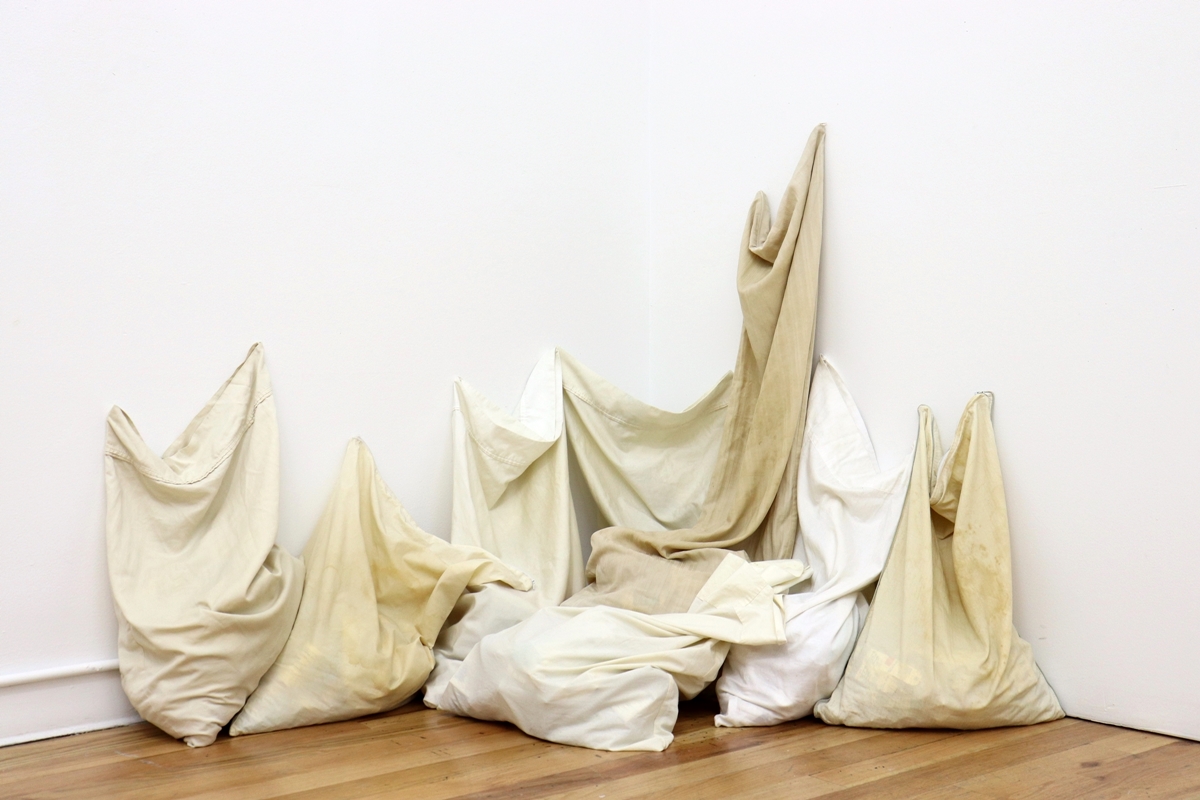
Image Description: Eight white and cream pillowcases stained from use sit vertically huddled together in a corner on hardwood floor. They reach upwards and lean structurally against white walls with wood trim at the bottom. One pillowcase is the size of a long body pillow. They are filled with medical supplies which tug the fabric and cause them to bulge. Other than hints of colors and shapes, their contents cannot be seen.
WORK STATEMENT
Pillow Fight consists of pillowcases stained from use and filled with years worth of medical supplies from both the artist’s life and gifted by their friends and family. The pillowcases huddle together in a corner and their contents are obscured. This opacity redirects away from pathology toward the necessity of care networks and support systems. Pillow Fight is an ongoing collective portrait that visualizes interdependence and togetherness, growing in number of pillowcases as time and supplies accumulate and is newly composed upon each installation.
ARTIST STATEMENT
Informed by queer-crip experience, community, and culture, I work to critique standards of productivity, notions of normative embodiment, and the commodification of rest. My interdisciplinary practice depicts the materiality of interdependence through used, found, or accumulated objects, slow pacing, and through collaboration. Drawing from both sites of and barriers to care, rest, and togetherness, I argue that to celebrate diverse bodyminds requires an anti-capitalist reconfiguration of time and value. Bedding is one of my primary materials which allows me to explore the bed as a site of collectivity and protest, as well as redefine what is typically considered to count as “work”. Through juxtapositions of domestic, industrial, and natural materials, such as diamond-plate flooring, coffee beans, and sweat-stained memory foam, I address the incompatibility of our needs with societal values of self-reliance, “hard work” and individualism. These tensions ask us to embrace slowness as well as recognize and honor our needs which are too often suppressed, consciously or unconsciously, to conform to white supremacist ideals of urgency, perfectionism, professionalism, and endless productivity. While the work speaks to the expansiveness of the self, specifics regarding the body and identity often remain opaque. Negating the demand placed on marginalized groups to provide an explanation, proof, or diagnosis, to reveal or obscure becomes a tactic in my practice as I navigate the politics of visibility, 24/7 society, and my own access needs as a chronically ill autistic trans person.
Artist Bio
Alex Dolores Salerno (b. 1994, homeland of the Nacotchtank, Anacostan, and Piscataway people, also known as Washington D.C.) is an interdisciplinary artist based in Lenapehoking, also known as Brooklyn, NY. Salerno received their MFA from Parsons School of Design and their BS from Skidmore College. They have exhibited at the Museum für Moderne Kunst (Frankfurt), Espacio de Arte Contemporáneo de Castellón (Castellón), ARGOS centre for audiovisual arts (Brussels), Art Windsor-Essex (Windsor), The Shelley & Donald Rubin Foundation’s 8th Floor Gallery, the Ford Foundation Gallery (NYC), among others. Salerno is a recipient of the 2022 Wynn Newhouse Awards, and their work has been featured in the New York Times and Art in America. They have been an artist in residence at Art Beyond Sight’s Art & Disability Residency (2019-2020), the Artist Studios Program at the Museum of Arts and Design (2021), the Visual Artist AIRspace Residency at Abrons Arts Center (2022-2023), and they are currently in residence at BRIClab: Contemporary Art (2023-2024).
When We Felt Together (at Workman Arts), 2023
Felt
Khadija Aziz
Khadija Aziz is a multidisciplinary artist and educator based in Toronto and Montréal. Not tied to any particular medium, she makes sense of her world through material gestures of mark-making. Throug... h her artistic and educational practice, she fosters community-building and individual development by establishing grounds for a collective learning experience. Khadija’s art has been exhibited in Canada, Australia, and Austria. Her most recent artist residency was at the Estonian Academy of Arts in Tallinn, Estonia. In recognition of my creative practice, Khadija received the Shanks Memorial Award in Textiles from Craft Ontario and the Creative Promise Award from Surface Design Association in 2020. She received the Award of Excellence in Community Engagement from the Ontario Museum Association in 2019 for her contributions to the Textile Museum of Canada.
Visibly Mended, 2022
Vintage indigo dyed shawls, linen sheet, cotton thread.
Brandon Wulff
Brandon Wulff is an Autistic quilt Artist who works with interior decorators and designers to create unique pieces....
“Sit Still” and “Look at Me,” 2022
2 chairs containing varioius objects wrapped in yarn and fabric.
Estée Klar &
Adam Wolfond
Estée Klar holds a PhD Critical Disability Studies from York University. Her dissertation, Neurodiversity in Relation: an artistic intraethnography is a collaborative work with Adam Wolfond, now a pu... blished writer and the first non-speaking classically autistic M.A. student in Canada. Klar is also a facilitator and an artist and founder of dis assembly, a lab for neurodiverse artistic experimentation involving processes that explore conditions and techniques for human and more-than-human relation and support located at Artscape Youngplace in Toronto. She collaborates with others around the world in these projects. Klar is also the founder/director of the former Autism Acceptance Project (2006—10) and its subsequent artistic-activist events, and the original blogger at The Joy of Autism (2004-8) which over the years has resonated throughout the autistic community. She is an artist and filmmaker and her can be seen at www.esteerelation.com and dis-assembly.ca.
Adam Wolfond is an autistic poet and artist who uses a device to speak. He has been featured poets.org as the youngest poet to ever be published there and his work has been featured in The New York Times Magazine (2023). Wolfond has also exhibited his film and installation work in Toronto, Canada. He is the co-founder of dis assembly in Toronto, an arts collective which practices techniques for neurodiversity. Languaging is a way of movement, a continual disassembling, challenging the way of neurotypical grammars for more diversities to come. His work can be viewed at adamwolfond.com and also, dis-assembly.ca. His chapbooks of poetry In Way of Music Water Answers Toward Questions Other Than What Is Autism, are available here at the studio. His book The Wanting Way which we are celebrating this evening is published by Milkweed Publishing Multiverse Series and In The Way of Water will be published by Punctum University Press in 2023.
Redwork: The Emperor of Atlantis, 2023
Antique fabric, embroidery
Catherine Heard
Catherine Heard’s practice employs fine craft as a foil for abject subject matter, delving into contested imagery and primal anxieties of the human psyche. Her current project, Redwork: The Emperor ... of Atlantis, invites the public to collaborate in the creation of a textile installation that utilizes traditional redwork embroidery techniques to engage histories of injustice. Her work has been exhibited internationally and is in the permanent collections of the Canada Council Art Bank, The Art Gallery of Hamilton, The Art Gallery of Kamloops, and The Robert McLaughlin Gallery. Catherine Heard holds an undergraduate degree from OCADU, and a Master of Visual Studies degree from the University of Toronto. She is an assistant professor at the School of Creative Arts of the University of Windsor. Catherine Heard is represented by Birch Contemporary Gallery in Toronto and online by CMS Art Projects.
Textiles are very in right now, 2018-present
series of rugs
Paulina Wiszowata
Paulina Wiszowata’s (she/they) innate interest in the art world manifests itself in her artistic practice, in which she critically reflects upon and examines many different notions of art and what i... t means to be an artist. Framing herself as a contemporary conceptual artist, she utilizes a multitude of motifs including humour, language and de-skilling in order to demonstrate these self-reflective concepts and her hyperawareness of them. Her identity as an artist is rooted in her training in the visual arts, with a primary focus on painting, performance, and most recently rugmaking; she uses these fields to construct an effortless appearance with the use of calculated gestures that both fulfill and critique her own identity. Art is simply the means in which she chooses to question herself, her community and her craft; in doing so, she attempts to understand the conventions of being an artist, where these conventions originate from and how they are defined.
